The advanced physiology section provides the opportunity to apply learned skills to advanced analysis and algorithm development to detect various clinical disorders based on features of the signal. Additional transducers are introduced, such as blood pressure cuffs and pulse oximeters.
Blood Pressure
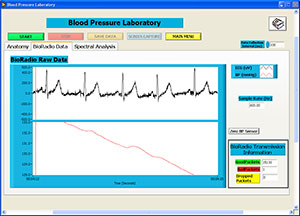
Non-invasive blood pressure measurements are made by wrapping a cuff around the arm. An analog electrical signal from the cuff along with an ECG signal is recorded during the lab. Students evaluate the signal, learn how to calculate systolic and diastolic levels and evaluate the relationship to the ECG signal.
Electromyography II
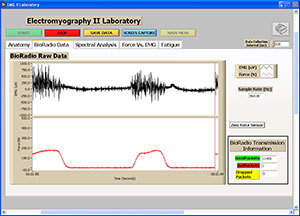
The relationship between force and EMG is analyzed while EMG is measured from the finger flexor muscle and a hand dynamometer is squeezed. A real-time display shows force as a function of EMG and students explore how quantitative features of the signal change during muscle fatigue.
Electrocardiography II

A clinical database of irregular cardiac data allows students to analyze the features of normal and abnormal ECG signals. Students develop algorithms to detect cardiac events based on quantitative characteristics of the signal and utilize a joint time-frequency analysis to view spectral changes over time.
Electroencephalography II
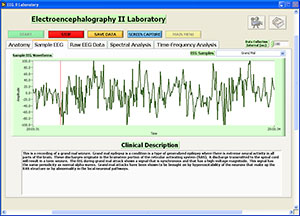
Students learn to detect abnormal brain function using a sample EEG database. Characteristics of normal EEG, seizure activity and grand mal seizure activity are analyzed and algorithms are developed to detect certain events. A joint time-frequency allows students to view spectral changes over time.
Pulse Oximetry
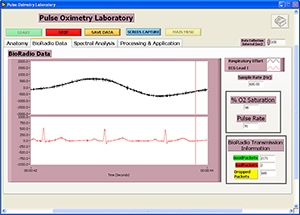
Students are introduced to pulse oximetry (blood oxygen saturation) and its clinical significance. Respiratory effort, ECG, percent oxygen saturation and heart rate are measured and analyzed.
Speech Recognition

The anatomy and function of the ear is introduced including the tonotopic organization of neurons, and gives students background on hearing and speech recognition. A microphone on the PC is used and temporal and spectral components of speech are explored. An algorithm is developed to detect different words under different conditions.
Pressure-Based Airflow
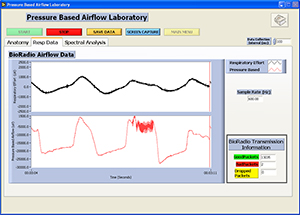
Students measure airflow using a plastic nasal/oral cannula and a differential pressure sensor built into the BioRadio. In addition to airflow, students detect and measure snore and learn how this plays a role in obstructive sleep apnea, a common sleep disorder.
Spirometry
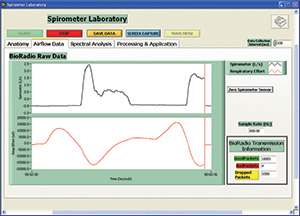
The basics of how a spirometer transducer converts airflow to an electrical output are reviewed. Flow rate is measured during inhalation and exhalation and the data is used to calculate lung volume. The output of the spirometer is then compared to that of a respiratory effort belt.
Biomechanics

A force plate is used and EMG is measured from the let to explore the EMG activity patterns that occur during jumping. Different phases of the jump are extracted from the data and students learn proper filtering to apply to the signals to remove noise and motion artifact.
